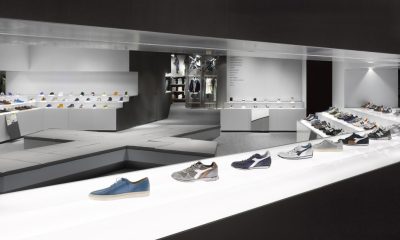To address the current and future challenges facing bricks-and-mortar stores, multi-channel and IT-integration will be important topics at EuroCIS, the Leading Trade Fair for Retail Technology. The event will take place from February 24 – 26, 2015 at the exhibition center in Düsseldorf, Germany.
Renovation of the IT Landscape
A complete IT system overhaul to achieve multi-channel enabled systems is an exception in retail today. Many stores only gradually upgrade to multi-channel systems by implementing single functionalities due to limited IT budgets. The motivation is to keep projects manageable and their costs controllable. “Retailers need a clear strategy for migrating to the multi-channel world that can be pursued step by step,” said Stefan Clemens, Area Sales Leader NCR Retail.
IT is a solution but often constitutes high obstacles – because the IT environment is typically designed for offline business. The web shops added later are often managed independently using different applications and other process logistics which complicate the linking of channels. “If you then try to link the individual applications separately with each other, you quickly end up in an “integration Nirvana,” stated Manfred Debus, Software Marketing Manager at Wincor Nixdorf. The result is so-called “spaghetti software” – IT architecture with numerous interfaces and unnecessary features and functions. This in turn can negatively impact the performance, maintenance friendliness and development potential of the system. And creating such links can also result in recurring problems due to incompatible data and transaction formats which may drive up the costs of an originally manageable project.
Advertisement
Possible Sources of Problems
Generally, there are three main issues that can lead to problems in the IT implementation of multi-channel applications:
The functional level. Identical or at least similar functions and data processing mechanisms must be offered on different systems. The processing logics of retail functionalities on different terminal devices (e.g. offline and online check outs) should not or only to a minor extent differ in order to avoid user errors or additional training. The consistent, constantly updated management of customers’ shopping carts is crucial for a successful multi-channel strategy.
The data structure level. Proprietary data structures and formats and their integration are among the greatest obstacles for the implementation of multi-channel strategies. Trying to link the individual applications and/or channels with each other separately quickly leads to an “integration Nirwana”. It is better to define an abstraction layer and/or conversion layer into which all solutions can be integrated.
Advertisement
The transaction processing level.Two problems must be addressed in particular: the big data volumes to be processed with multi-channel transactions and the non-stop availability of current data. Both go hand in hand with the bandwidth available for data transfer, i.e. a purely technical problems as well as with smart transaction management. Data buffering (e.g. in the offline case) and the targeted passing on of data are solutions.
Managing Large Data Qualities
“To us one of the most important topics concerning omni-channel scenarios is the real-time availability of the right data and services, at any place and any time,” explained Michael Jaszczyk, Technology Board of GK Software. “In the foreseeable future consumers’ mobile devices, retailers’ online shops and the offline systems will be much more closely linked than is currently the case. The major challenges here will be the complete and seamless integration of conventional and future sales channels as well as managing the associated big data sets. This is why we are currently focusing heavily on the relevant technologies – such as SAP Hana, in particular – which are the first to provide the necessary performance for omni-channel retailing.”
Centralizing Data
“A comprehensive omni-channel solution, as offered by Toshiba in conjunction with ERP solutions, covers the transactions of all retail channels, compiles them in a central place and then makes them available to the staff again for talking to their customers,” noted Klaus Smets, General Manager at Toshiba. “The Toshiba solution TCxGravity works with centralized data and processes. This means that there is no data replicated in various applications. After all, redundant data and processes increase the complexity as well as the sources of potential errors. In contrast to this, the Toshiba solution architecture resides in a company-wide infrastructure. So staff members have everything under control again – regardless of where they are, they know which items are in stores or will soon be available again.”
Advertisement
Seamless Integration with Existing Systems
“With our TP Application Suite our responsibility is to support all retail sales-related processes,” remarked Manfred Debus of Wincor Nixdorf. “Modern integration mechanisms supported by service technologies enable us to seamlessly integrate with the existing components of the IT landscape. To reduce IT complexity and ensure functional orientation towards end user needs at the various points of sale we recommend centralizing rather than positioning the direct interaction points between ERP and Point-of-Purchase solutions at outlet level. The degree of possible and wanted centralization here depends on network topologies, the degree of autonomy desired for stores as well as on the given retail-relevant processes.”
More than just an IT Project
“In general companies aim to generate synergies between offline and e-commerce by implementing multi-channel concepts,” reported Peter Dietrich, Product Manager Höltl Retail Solutions. “Although this goes hand in hand with a fundamental change of business processes as a rule, multi-channel projects are often mistaken for IT-only projects and the analysis and/or optimization of business processes is neglected. The requirements of multi-channel retailers are complex. Fulfilling them generally requires a composition of several IT systems. Often, one crucial challenge of multi-channel projects is to achieve a sufficient degree of integration between the IT systems affected, all the more as these frequently come from different manufacturers. This is where the multi-channel solution by Höltl Retail Solutions comes in.”
Platform for All Touch Points
“Classic e-commerce retailers want to venture into bricks-and-mortar retail and have to equip themselves accordingly in terms of both hardware and software. In contrast to this, offline retailers often find it difficult to think in online categories,” noted Stefan Clemens of NCR. “For both channels different infrastructures are necessary, which – as a rule – are not in existence and have to be created first. The networking of products and channels, the preparation and availability of real-time data and the integration of the infrastructure are the challenges that both offline and online retailers have to address. Technologies are called for that ease the burden for sales staff, minimize efforts for retailers while allowing better sales assistance geared to shoppers’ individual preferences. Serving all the various channels both online and offline is key for meeting shoppers’ rising service expectations. In addition to matching hardware and services NCR offers the comprehensive, cross-channel software platform NCR Retalix R10 that covers all touch points for shoppers in one central place.”
At EuroCIS 201, the international retail sector will come together and find the latest solutions for making existing processes and structures fit for multi-channel operations and learn which innovative systems are currently available on the market and how these can be tailored to specific needs. Reduced entrance passes can be ordered online atwww.eurocis.com (Euro 17 for a 1-day pass, Euro 30 for a 2-day pass). All tickets allow free use of public transportation to and from the show within Düsseldorf.
For further information on visiting or exhibiting at EuroCIS 2015 contact Messe Düsseldorf North America, 150 North Michigan Avenue, Suite 2920, Chicago, IL 60601. Telephone: (312) 781-5180; Fax: (312) 781-5188; E-mail:info@mdna.com; Visit our web site http://www.mdna.com; Subscribe to our blog http://blog.mdna.com; Follow us on twitter at http://twitter.com/Retail_MDNA
For hotel and travel information, contact TTI Travel, Inc. at (866) 674-3476; Fax: (212) 674-3477; E-mail:info@ttitravel.net; www.traveltradeint.com

 Photo Gallery1 week ago
Photo Gallery1 week ago
 Headlines4 days ago
Headlines4 days ago
 Headlines1 week ago
Headlines1 week ago
 Headlines2 weeks ago
Headlines2 weeks ago
 Headlines1 week ago
Headlines1 week ago
 Designer Dozen1 week ago
Designer Dozen1 week ago
 Headlines1 week ago
Headlines1 week ago
 Headlines1 week ago
Headlines1 week ago





















